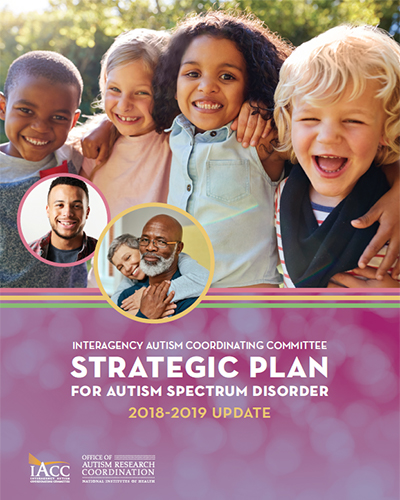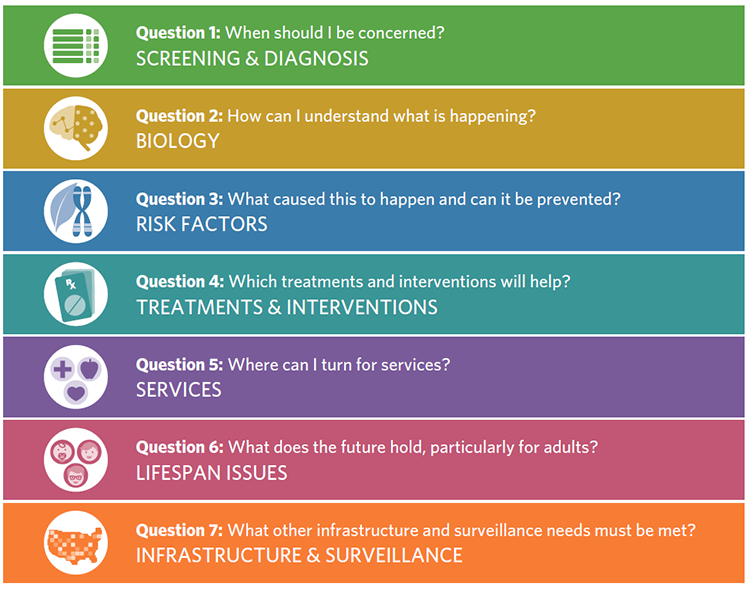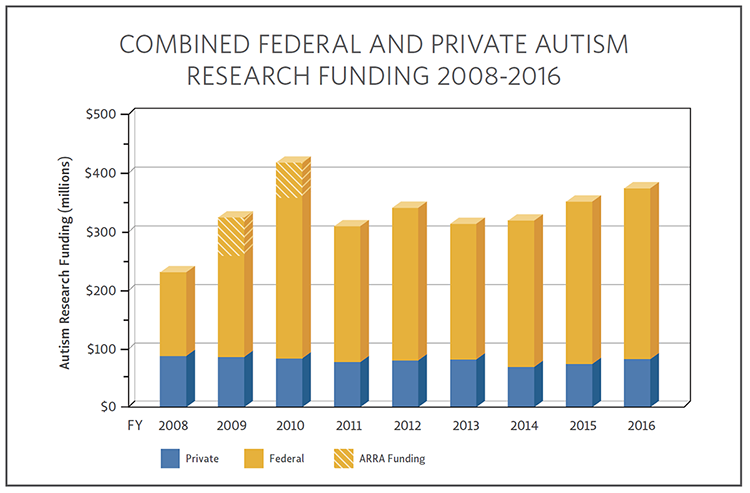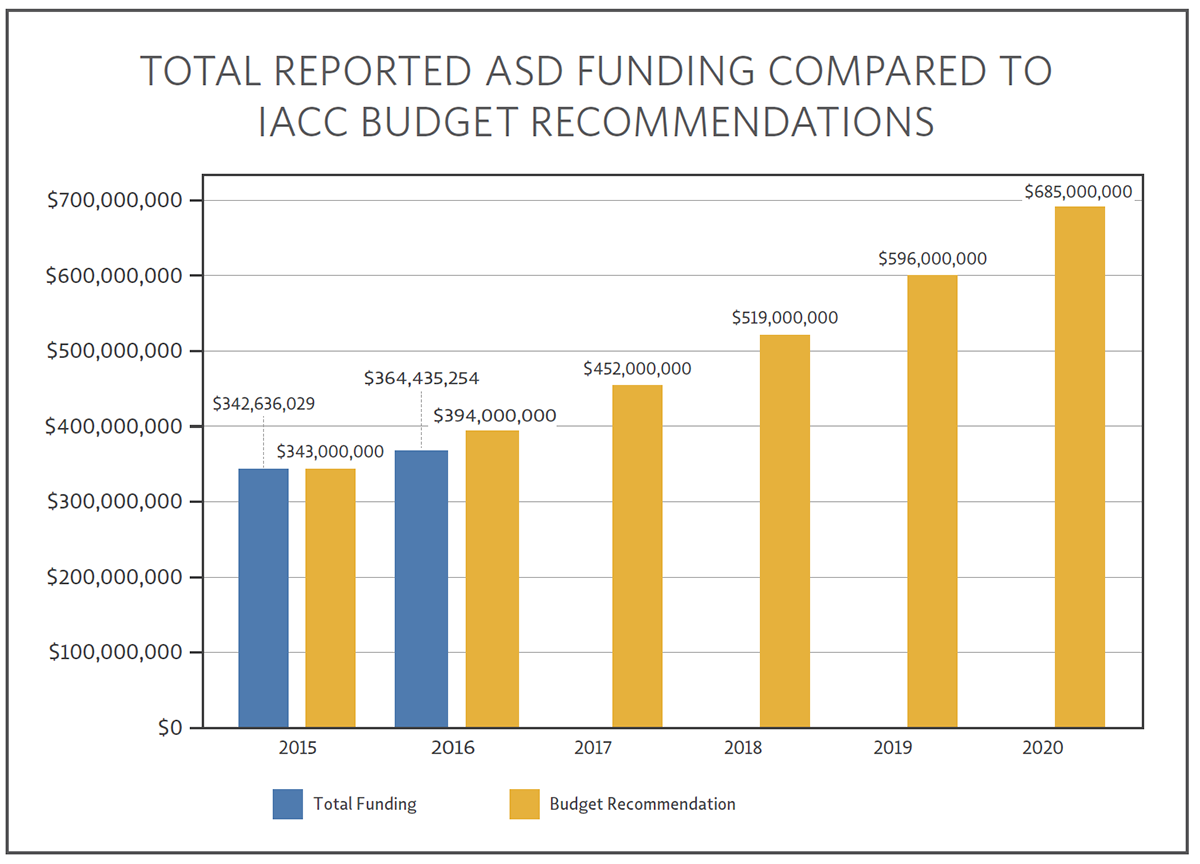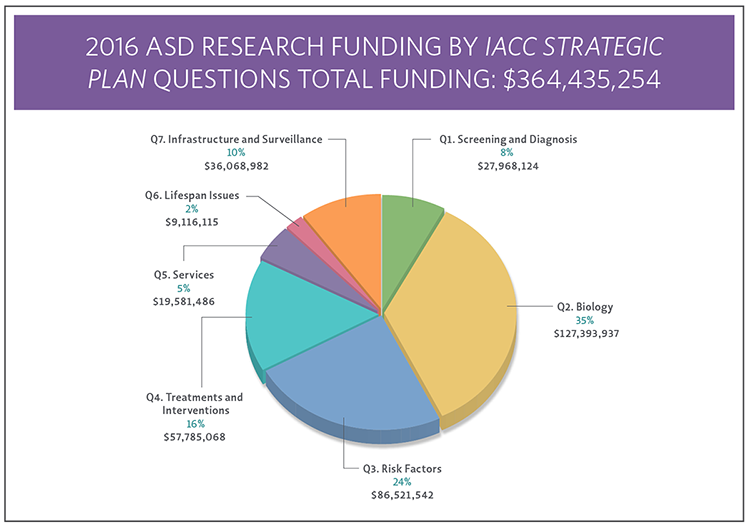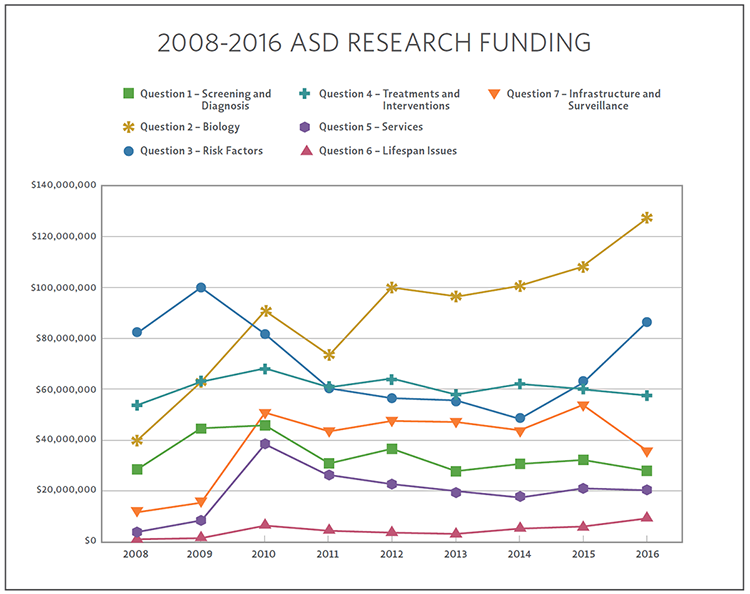IACC Strategic Plan
For Autism Spectrum Disorder
2018-2019 Update

Background
This chapter will provide an overview of the findings reflected in the 2016 IACC Autism Spectrum Disorder Research Portfolio Analysis Report, which provides the first analysis of research projects funded by federal and private research funders in the U.S. according to the objectives in the 2016-2017 IACC Strategic Plan for Autism Spectrum Disorder Research. This overview will describe progress toward the IACC Strategic Plan objectives.
Following the development of the first IACC Strategic Plan in 2009, the Office of Autism Research Coordination (OARC)—the office within the National Institutes of Health (NIH) that manages the activities of the IACC—began publishing a series of IACC ASD Research Portfolio Analysis Reports to provide the IACC with comprehensive information about the status of autism research funding among federal agencies and private research organizations in the United States. The reports align data on individual research-related projects with objectives in the IACC Strategic Plan, providing an accounting of how much funding has supported projects related to Strategic Plan objectives and highlighting trends. For the Portfolio Analyses, the seven questions are categorized by their broad research areas (Figure 2); for example, Question 1 is labelled Screening & Diagnosis and Question 2 is named Biology.
The Portfolio Analysis Reports have been used to help the IACC in their efforts to monitor ASD research efforts and track progress made each year on the objectives in the IACC Strategic Plan. the 2016 IACC ASD Research Portfolio Analysis Report is the first portfolio analysis measuring progress made toward the 23 new objectives in the 2016-2017 IACC Strategic Plan for ASD. Funding information from 2016 federal and private funders is aligned with an objective within one of the seven questions in the Strategic Plan. In addition to research progress towards the objectives in the Strategic Plan, the 2016 IACC ASD Research Portfolio Analysis Report provides an analysis of progress that was made in ASD research over the nine-year period from 2008-2016, subcategory analysis within each question of the Strategic Plan, geographical funding information, and more.
Lastly, the 2016 Portfolio Analysis Report addresses the Committee’s recommended ASD research budget of $685 million by 2020. To accomplish this goal, the Committee recommended a nearly 15% annual increase in ASD research funding for 2016. This summary will discuss progress towards meeting the annual budget recommendations as well as highlight some of the major findings in the 2016 Portfolio Analysis and how they relate to the goals of the 2016-2017 IACC Strategic Plan.
IACC Strategic Plan Questions and Corresponding Research Areas
Figure 2. The seven questions and corresponding research areas of the 2016-2017 IACC Strategic Plan for ASD.
Highlights from the Report
ASD Research Funders And Funding In 2016
For the 2016 IACC ASD Research Portfolio Analysis Report, OARC requested information on 2016 autism-related research projects funded by several federal agencies and private organizations. Information included the annual funding amount and the relevance of each project to the seven questions of the 2016-2017 IACC Strategic Plan for ASD. For 2016, nine federal agencies and nine private funders provided their autism research funding information for this analysis. These 18 agencies and organizations are listed in Table 1.
| Federal Agencies | Private Organizations |
|---|---|
Federal Agencies
|
Private Organizations
|
Table 1. Projects from nine Federal agencies and nine private organizations were included in the 2016 IACC ASD Research Portfolio Analysis Report.
In 2016, the estimated federal and private investment in ASD research totaled $364,435,254 and included 1,360 projects. The federal government provided 80% of total ASD research funding, which amounted to $291.7 million. One-fifth of funding was provided by private organizations, which invested $72.7 million. Compared to the previous year, there was an increase in federal and private investment in 2016, which supported the overall increase in funding.
Over the nine-year span from 2008-2016, funding increased by 64.3%, suggesting a continued overall growth in support of ASD research although there have been fluctuations from one year to the next (Figure 3). Autism research reached a peak in funding (including funds from the American Recovery and Reinvestment Act) in 2010 and then experienced lower, but overall increasing levels of funding over the next few years. By 2016, the ASD research portfolio was funded at the highest level since 2010, suggesting increased interest in ASD research.
Figure 3. This figure illustrates levels of autism research funding from combined federal and private sources during 2008-2016 based on data collected for the IACC Portfolio Analysis of those years.
With regard to the 2016-2017 IACC Strategic Plan’s budget recommendation, the 2016 funding amount of $364.4 million did not reach the recommended budget of $394 million for that year. However, the overall funding for autism research increased by $21.7 million from 2015 to 2016, an increase of 6.3%. While this did not meet the budget recommendation, ASD research did experience a substantial growth in funding for 2016 (Figure 4). In future years, funding trends will continue to be monitored to determine progress toward meeting the IACC’s recommended budget.
Figure 4. The IACC recommends a doubling of the combined federal and private ASD research budget to $685 million by 2020. Based on 2015 and 2016 funding amounts, ASD research investment is lagging behind IACC budget recommendations.
ASD Research Areas and Progress In 2016
To better understand which areas of research were funded in 2016, projects were aligned with the questions in the 2016-2017 IACC Strategic Plan. Figure 5 illustrates the breakdown of the research funding per each of the Strategic Plan’s seven questions, which are related to Screening and Diagnosis (Q1), Biology (Q2), Risk Factors (Q3), Treatments and Interventions (Q4), Services (Q5), Lifespan Issues (Q6), and Infrastructure and Surveillance (Q7). Identifying how current research investments correspond to the Strategic Plan provides an understanding of how funders have directed investments across each of the priority areas identified by the IACC, as well as an indication of which areas are well-supported versus those that may need additional attention or development.
Figure 5. The seven questions of the Strategic Plan, beginning with Screening and Diagnosis (Question 1) and ending with Infrastructure and Surveillance (Question 7).
ASD research funding in 2016 supported projects relevant to all seven questions in the IACC Strategic Plan for ASD. As in previous years, the largest portion of funding addressed the underlying biology of ASD (35%). Projects assigned to this research area seek to understand the biological differences and mechanisms in early development and throughout life that contribute to ASD symptoms, as well as the characterization of the behavioral and cognitive aspects of ASD. The next largest funded research area was risk factors, with research aimed at identifying potential causes, genetic and/or environmental, for ASD (24%). Research into treatments and interventions for ASD followed in funding (16%), which included funding towards behavioral therapies, pharmacological treatments, and technology-based interventions. In 2016, ASD funders supported research towards infrastructure and surveillance, which consisted of 10% of total funding. Projects within the infrastructure and surveillance category include large-scale studies that require coordinating centers and dissemination of data to the community as well as investment towards large databases. Research to improve screening and diagnosis of ASD followed closely with 8% of research funding. Projects within screening and diagnosis include research to develop and improve biomarkers, screening tools, and diagnostic instruments to aid in early identification. Research focused on services and lifespan issues were the least funded research areas. Services, which includes research on improving the efficacy, cost-effectiveness, and dissemination of evidence-based practices in community settings, received 5% of ASD research funding. Lifespan Issues, which encompasses research to identify and address the needs of transitioning youth with ASD to adulthood and throughout the lifespan, received 2% of funding.
The 2016 Portfolio Analysis represents the first time that funding information was aligned with the 23 new objectives in the 2016-2017 IACC Strategic Plan. For 2016, there was funding and/or projects associated with each of the 23 new objectives, reflecting alignment of the IACC’s research goals with those of federal and private funders. In the following years, OARC will continue to assess funding levels among the new objectives.
While the IACC has created 23 new objectives to track ASD research investments, funding information related to the seven question areas of the IACC Strategic Plan has been collected across a nine-year span (Figure 6). Over the years, research into understanding the underlying biology of ASD and infrastructure and surveillance have seen significant increases in funding. The areas of services research and lifespan issues have been consistently less well funded than other research areas. Research towards screening and diagnosis, risk factors, and treatments and interventions have fluctuated in funding through the years.
Over time, the IACC will update and replace objectives in the Strategic Plan to reflect advances in research and changes in services and policy, however, the framework of the seven question areas will remain constant, allowing the tracking of funding trends over extended periods. This is helpful for the Committee as well as stakeholders within the ASD community in identifying areas and priorities for future research investment.
Figure 6. Trends in ASD funding for each Strategic Plan Question over the nine-year period of reporting (2008-2016).
Summary
the 2016 IACC ASD Research Portfolio Analysis Report provides the ninth year of data collected and the seventh comprehensive report of U.S. ASD research funding across both the federal and private sectors. It is also the first analysis to measure research progress against the 23 new objectives from the 2016-2017 IACC Strategic Plan. ASD research project information was collected from 18 federal and private funders. Similar to previous years, federal agencies continued to fund the majority (80%) of ASD research while private organizations contributed nearly 20% of funding. Overall, funding for ASD research among both federal and private funders totaled $364.4 million and spanned 1,360 projects in 2016. With nine years of ASD research funding data available (2008-2016), it was possible to continue analyzing the long-term progress in ASD research. Since 2008, autism research showed an overall upward trend in funding, increasing by 64.3%.
The framework of the seven questions in the Strategic Plan has remained unchanged since in their inception in 2008, which is beneficial to tracking trends in research investments. For 2016, each Strategic Plan question sustained similar proportions in funding compared to recent years, showing consistent support for certain research areas of the Strategic Plan. However, this was the first year assessing funding towards the new objectives in the 2016-2017 IACC Strategic Plan. Although it was the first year monitoring progress on these objectives, every objective in the 2016-2017 Strategic Plan had associated projects and/or funding in 2016. This indicates that the priority areas identified by the IACC in the Strategic Plan objectives were also identified as priority areas by federal and private research funders, though some areas still have much room for growth. For an in-depth analysis of the new objectives, please refer to the 2016 IACC Portfolio Analysis Report.
In response to the budget recommendation set out in the 2016-2017 IACC Strategic Plan, the 2016 ASD research budget experienced less growth (6.3%) in funding for the year than the 15% increase which would have kept the recommendation on track to be reached. While this amount did not hit the annual goal requested in the Strategic Plan, it still signifies growth in ASD research funding. Over the next few years, OARC will continue to track funding trends and determine progress toward meeting the IACC’s budget recommendation.
The annual IACC ASD Research Portfolio Analysis Report assists the Committee with carrying out its charge to monitor autism activities and to inform the process of updating the IACC Strategic Plan. Future portfolio analyses tracking the 2016-2017 IACC Strategic Plan’s 23 objectives will continue to serve as a resource for the Committee, funders, and the broader ASD community to monitor progress, identify knowledge gaps, recognize emerging trends and new opportunities, and guide future research investments to better meet the needs of families and individuals affected by ASD.
To see the full analysis of the 2016 funding data, including funder information, geographical funding data, trends in ongoing versus new research, subcategory analysis, and more, please view the 2016 IACC ASD Research Portfolio Analysis Report on the IACC website. The project data are publicly accessible in the IACC/OARC Autism Research Database, also available on the IACC website.


